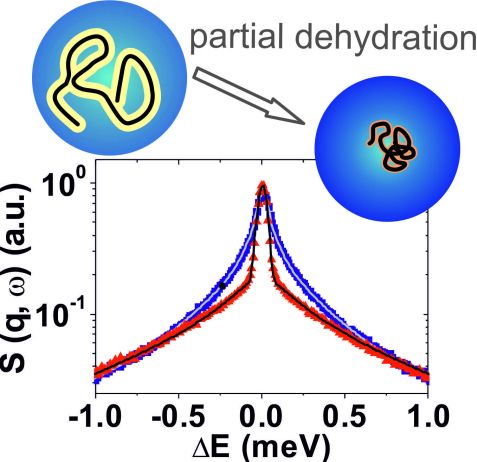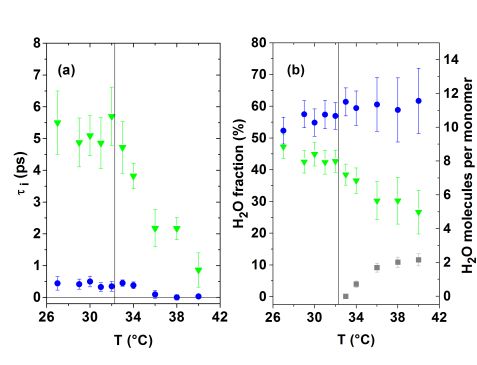MLZ is a cooperation between:
 > Technische Universität München
> Technische Universität München > Helmholtz-Zentrum Hereon
> Helmholtz-Zentrum Hereon
 > Forschungszentrum Jülich
> Forschungszentrum Jülich
MLZ is a member of:
 > LENS
> LENS > ERF-AISBL
> ERF-AISBL
MLZ on social media:

MLZ (eng)
Lichtenbergstr.1
85748 Garching
From molecular dehydration to excess volumes of demixing thermo-responsive polymer solutions
M. Philipp1, K. Kyriakos1, L. Silvi1,2, W. Lohstroh1,2, W. Petry1,2, J. K. Krüger3,4, C. M. Papadakis1, and P. Müller-Buschbaum1
1Physik-Department E13, Technische Universität München, Garching, Germany
2Heinz Maier-Leibnitz Zentrum (MLZ), Technische Universität München, Garching, Germany
3Laboratoire de Physique des Matériaux, Université du Luxembourg, Luxembourg, Luxembourg
4Fakultät für Werkstoffwissenschaften, Universität des Saarlandes, Germany
Environmentally responsive polymers are of interest in view of their current use, and foreseen future implementation in everyday life. Typical fields of application are soft robotics, sensors, drug delivery systems, and stimuli-responsive surfaces. The working principle of these smart polymeric materials is based on a demixing phase transition, leading to massive changes in volume and elasticity. To elucidate the underlying mechanisms of phase separation, we investigate the dehydration of model thermo-responsive polymers in an aqueous environment using the time-of-flight spectrometer TOF-TOF. Our neutron scattering studies are of particular value for a deeper understanding of the nature of the molecular driving mechanisms of the demixing process, their impact on macroscopic order parameter susceptibilities, and a better theoretical description of the dehydration.
Environmentally responsive polymers in an aqueous environment
In engineering, bioengineering and medicine there is a huge demand for tailor-made polymeric materials that possess the ability to undergo massive changes in their volume, their elasticity or related properties when exposed to small stimuli [1]. In order to design novel stimuli-responsive materials with the desired switching behavior, a multitude of complex architectures of responsive hydrogels, brushes, thin films, colloids and micellar systems have been synthesized. The switching mechanism is generally provoked by a sharp demixing phase transition, which is often of the lower critical solution temperature type for aqueous systems. In the case of hydrogels the phase separation is commonly denoted as a volume phase transition, which hints at the fact that the volume expansion coefficient can be considered as the macroscopic order parameter susceptibility. On the molecular scale, important variations in hydrophobic interactions and hydrogen bond interactions seem to govern the phase separation and provoke a coil-to-globule transition in the case of individual polymer chains [2]. As a consequence, important changes in structure and in molecular diffusion occur.
One prerequisite for major progress and future innovation in this growing field of smart synthetic polymeric materials is a more fundamental understanding of the molecular driving mechanisms of the phase separation. Another crucial point is the elucidation of the impact of the molecular processes on those properties, which are strongly coupled to the macroscopic order parameter. In order to contribute to these issues, we study the demixing transition of model responsive materials, namely aqueous solutions of the classical thermo-responsive polymer called poly(N-isopropylacrylamide) (PNIPAM) [4,5]. The study of simple PNIPAM solutions – as compared to the above-mentioned technologically more valuable materials such as hydrogels, or thin films – enables us to concentrate on the basics of the phase transition by avoiding its interference with mechanical constraints exerted on the macromolecules by covalent network knots or by interfacial interactions.
Dehydration behavior of phase-separating, thermo-responsive solutions
Changes in intermolecular interactions and in molecular transport are at the origin of the phase separation [1-5]. Here, we focus on the diffusion dynamics of the hydration water and the almost freely diffusing water across the demixing transition of a concentrated aqueous solution of 25 mass% PNIPAM with the aim of accessing the molecular order parameter [5]. Its demixing temperature lies at 32.2 °C. The incoherent neutron scattering experiment was performed at the cold neutron time-of-flight spectrometer TOF-TOF at the MLZ in Garching. Fig. 1 shows that the central part of the spectra significantly varies as the demixing temperature is crossed. A schematic drawing of the partial dehydration and the structural changes of a macromolecule subjected to the related coil-to-globule transition is also included in the figure. The scattering curves below and above the phase transition have been analyzed assuming a diffusion model of two different water populations, which will be denoted in the following weakly bound water and almost freely diffusing water (plus the elastic contribution). As expected, the isotropic jump diffusion model is applicable to both water populations and the average residence time τi and the relative fractions are shown in Fig. 2. The average residence times, before jumping to another position, of the weakly bound hydration water clearly decreases in a remarkably continuous manner as it is expelled from the hydration shells. It approaches the value observed for the almost freely diffusing water of the phase-separating solution. The fraction of the different water populations also changes upon demixing (see Fig. 2(b)). Whereas most of the weakly bound hydration water is expelled from the hydration shells during phase separation, our studies indicate that the mobility of part of the hydration water is significantly reduced above the demixing temperature. This can be concluded from the increase of the observed elastic intensity (Fig. 2(b), grey symbols). Hence, only a partial dehydration of the macromolecules seems to occur and the hydration number decreases by about six for the considered demixing 25 mass% PNIPAM solution.
Impact of dehydration on the excess volumes released during phase separation
We elucidated the impact of molecular dehydration on the macroscopic order parameter susceptibility by studying, in addition, the volume expansion coefficients α(T) of phase-separating dilute to concentrated aqueous PNIPAM solutions [5]. Since α(T) shows a peak-like feature during phase separation, the demixing solutions significantly expand. This is attributed to a less dense packing of the water molecules, as they are expelled from the hydration shells that envelop the PNIPAM chains. A qualitative understanding of the relationship between the molecular and macroscopic key processes governing the demixing transition could be provided in the frame of the immense strain-softening of the ferroelastic-like, phase-separating solutions [4,5]. To conclude, our incoherent neutron scattering experiment provides important insight into the molecular-mechanistic origins of demixing transitions, as well as of the dehydration process of PNIPAM, and related synthetic and biological polymers.
References:
[1] I. Tokarev et al., Soft Matter 5, 511 (2009).
[2] Y. Maeda et al., Langmuir 16, 7503 (2000).
[3] A. Laschewsky et al., Prog Colloid Polym Sci 140, 15 (2013).
[4] M. Philipp et al., Soft Matter 9, 5034 (2013).
[5] M. Philipp et al., J. Phys. Chem. B 118, 4253 (2014).
MLZ is a cooperation between:
 > Technische Universität München
> Technische Universität München > Helmholtz-Zentrum Hereon
> Helmholtz-Zentrum Hereon
 > Forschungszentrum Jülich
> Forschungszentrum Jülich
MLZ is a member of:
 > LENS
> LENS > ERF-AISBL
> ERF-AISBL
MLZ on social media:




